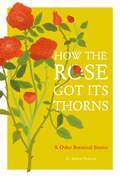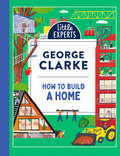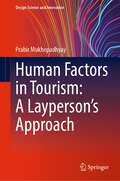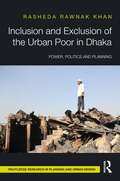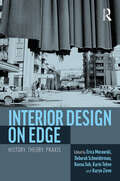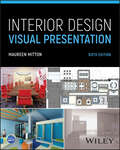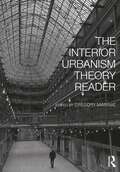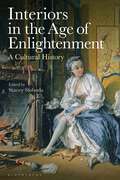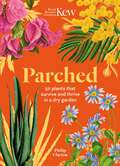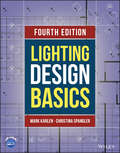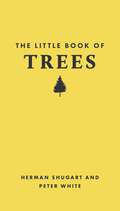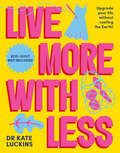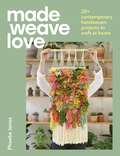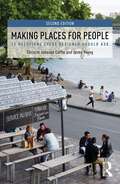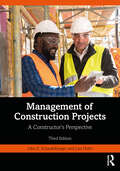- Table View
- List View
Housing in the United States: The Basics (The Basics)
by Katrin B. AnackerHousing matters to people, be they owner, renter, housing provider, homeless individual, housing professional, or policymaker. Housing in the United States: The Basics offers an accessible introduction to key concepts and issues in housing—and a concise overview of the programs that affect housing choices, affordability, and access in the United States today. Part I covers the fundamentals of housing: households, housing units, and neighborhoods; housing as basic need vs. human right; supply and demand; construction, rehabilitation, and renovation; and demographic, socioeconomic, and cultural trends. Part II focuses on housing policy and its evolution from the early 20th century, through the Great Recession to the present day; policies related to owner- and renter-occupied housing; tax policies and expenditures; place- and people-based programs; and shortages of affordable housing.Written in a clear and engaging style, this guide allows readers to quickly grasp the complex range of policies, programs, and factors that shape the housing landscape. Essential reading for students, community advocates, homebuyers/renters, and professionals with an interest in housing, it also serves as an ideal text for introductory courses in urban planning, urban studies, sociology, public administration, architecture, and real estate.This book provides a valuable and practical foundation for informed housing discussions at the kitchen table, in the classroom, at work, or on Capitol Hill.
How the Rose Got Its Thorns: And Other Botanical Stories
by Dr Andrew OrmerodHave you ever wondered why the rose has thorns and other flowers don't; why the daffodil is the colour it is; or why some plants have shiny leaves and others matt?How The Rose Got its Thorns reveals the inner workings of our favourite flowers and trees. Designed to help gardeners, both novice and experienced, better understand how plants grow, the book is easy to navigate - it is divided into 50 chapters, each one a story.Accompanied by specially commissioned colour illustrations, each chapter explains the science behind how plants work and the extraordinary processes they have evolved: such as protecting themselves from predators using chemicals; attracting pollinators using scent, shape and colour; growing in low or high temperatures; their relationship with the wind; the size and pattern of their leaves; the distribution of their seeds and survival strategies; their relationship with insects; how they allocate their resources; and how they retain water efficiently.This delightful and intriguing book offers readers an accessible way to better understand how our plants evolved into the species of today.
How to Build a Home (Little Experts #Book 5)
by George ClarkeGet designing and building with architect and TV presenter GEORGE CLARKE. From marvellous materials to future tech – discover the stories behind our homes.
Human Factors in Tourism: A Layperson's Approach (Design Science and Innovation)
by Prabir MukhopadhyayThe textbook covers the application of human factors in different facets of tourism and hospitality industry. It talks about appropriate ambience creation for guests, so they can enjoy their stay. This book enumerates different human factors aspects of dealing with tourists, conducting guided tours, or ensuring that tourists are completely satisfied from the tour in detail but in a layperson’s language. This book discusses details of the application of human factors in the tourism sector. This book aims to fill the gap between the literature available on tourism that deals with people and human factors that deals with the interaction among people, space, and products. This book aids the students and instructors in understanding and teaching different human factors issues in this sector. Further, this book will help professionals in the industry in providing quality services to their clients.
Inclusion and Exclusion of the Urban Poor in Dhaka: Power, Politics, and Planning
by Rasheda Rawnak KhanInclusion and Exclusion of the Urban Poor in Dhaka explores how the inhabitants of poor neighborhoods in Dhaka, Bangladesh, gain inclusion in the city at the face of exclusion. The book considers how the people of poor neighborhoods encounter the exclusionary behavior of city development, and how their inclusionary attempts have influenced the urban design. The book is presented in two parts: first, it explains how people in poor neighborhoods face exclusion because of the imbalance of power and politics. Second, it demonstrates how the existing exclusion of urban poor is affecting their strategies to gain access to urban services through people’s power and politics. Focusing on the transdisciplinary field of urban anthropology, the chapters uncover the urban forces, policies and actions that facilitate urban politics. It also investigates the people who live in poor neighborhoods, who in the face of exclusion, have included themselves in urban development planning and design by employing diverse strategies against those forces in the urban politics, e.g., accepting dominance, bargaining, or having control over their lives. This book will recontextualize an ethnographic inquiry into the exclusion and inclusion of the people within city development design, plans and innovations in applications of anthropological theory and methodology. This book will encourage the reader to understand the politics of state’s development projects and plans, and furthermore instigate the city government, planners and policymakers to focus on the people's political power and agency that enables them to achieve inclusion. It will therefore be of interest to researchers and students of urban planning and development, urban geography, and urban anthropology, as well as planning professionals and policymakers.
Inclusion and Exclusion of the Urban Poor in Dhaka: Power, Politics, and Planning
by Rasheda Rawnak KhanInclusion and Exclusion of the Urban Poor in Dhaka explores how the inhabitants of poor neighborhoods in Dhaka, Bangladesh, gain inclusion in the city at the face of exclusion. The book considers how the people of poor neighborhoods encounter the exclusionary behavior of city development, and how their inclusionary attempts have influenced the urban design. The book is presented in two parts: first, it explains how people in poor neighborhoods face exclusion because of the imbalance of power and politics. Second, it demonstrates how the existing exclusion of urban poor is affecting their strategies to gain access to urban services through people’s power and politics. Focusing on the transdisciplinary field of urban anthropology, the chapters uncover the urban forces, policies and actions that facilitate urban politics. It also investigates the people who live in poor neighborhoods, who in the face of exclusion, have included themselves in urban development planning and design by employing diverse strategies against those forces in the urban politics, e.g., accepting dominance, bargaining, or having control over their lives. This book will recontextualize an ethnographic inquiry into the exclusion and inclusion of the people within city development design, plans and innovations in applications of anthropological theory and methodology. This book will encourage the reader to understand the politics of state’s development projects and plans, and furthermore instigate the city government, planners and policymakers to focus on the people's political power and agency that enables them to achieve inclusion. It will therefore be of interest to researchers and students of urban planning and development, urban geography, and urban anthropology, as well as planning professionals and policymakers.
Interior Design on Edge: History, Theory, Praxis
Interior Design on Edge explores ways that interiors both constitute and upset our edges, whether physical, conceptual or psychological, imagined, implied, necessary or discriminatory.The essays in this volume explore these questions in history, theory, and praxis through a focus on different periods, cultures, and places. Interior Design on Edge showcases new scholarship that expands and contests traditional relationships between architecture, interiors, and the people that use and design them, provoking readers to consider the interior differently, moving beyond its traditional, architectural definition. Focusing on the concept of interiority considered in a wider sense, it draws on interdisciplinary modes of investigation and analysis and reflects the latest theoretical developments in the fields of interior design history and practice.With new research from both established and emerging authors, this volume will make a valuable contribution to the fields of Interior Design, Architecture, Art and Design History, Cultural History, Visual Culture Studies, and Urban Studies.
Interior Design on Edge: History, Theory, Praxis
by Erica Morawski Deborah Schneiderman Keena Suh Karin Tehve Karyn ZieveInterior Design on Edge explores ways that interiors both constitute and upset our edges, whether physical, conceptual or psychological, imagined, implied, necessary or discriminatory.The essays in this volume explore these questions in history, theory, and praxis through a focus on different periods, cultures, and places. Interior Design on Edge showcases new scholarship that expands and contests traditional relationships between architecture, interiors, and the people that use and design them, provoking readers to consider the interior differently, moving beyond its traditional, architectural definition. Focusing on the concept of interiority considered in a wider sense, it draws on interdisciplinary modes of investigation and analysis and reflects the latest theoretical developments in the fields of interior design history and practice.With new research from both established and emerging authors, this volume will make a valuable contribution to the fields of Interior Design, Architecture, Art and Design History, Cultural History, Visual Culture Studies, and Urban Studies.
Interior Design Visual Presentation
by Maureen MittonINTERIOR DESIGN VISUAL PRESENTATION Comprehensive guide covering all aspects of visual design, including planning, layout, and presentation. Interior Design Visual Presentation comprehensively addresses the visual design and presentation skills of the interior designer, featuring thorough, process-oriented coverage on the planning, layout, and the design of interior building spaces and guiding readers through techniques for executing creative and successful design graphics, models, and presentations. Color illustrations throughout the text feature a wide array of residential, institutional, and commercial settings designed to highlight step-by-step instructions. This newly updated and revised Sixth Edition includes a new overview of the design process for commercial design for students at all levels. Other revisions include new discussion of the impact of digital communication, examples of rendering materials in color, review of the latest tools for digital rendering, additional detail on creating hand drawings, and advanced technologies for physical model making, along with updated 3D modeling tutorials on Sketchup, Revit, Photoshop, and discussion of building information management (BIM) related to design intent and hand and digital rendering. Interior Design Visual Presentation includes information on: The design process and related graphics, covering diagrams and programming analysis graphics, programming matrices, schematic design, and design developmentParaline and perspective drawings, and sketching interior environments using photographs and perspective grid chartsMaterials, media, and tools involved in rendering by hand and constructing physical and digital scale modelsOrganization and composition guidelines when constructing boards, physical presentations, and digital presentationsGraphic design components, public speaking, and design communication when making a complete presentation Covering all aspects of visual design and presentation that interior designers need to know, Interior Design Visual Presentation is a highly accessible and valuable resource for students and professors in primarily first- and second-year courses in interior design degree programs, along with professional interior designers studying for the NCIDQ exam.
Interior Design Visual Presentation: A Guide To Graphics, Models, And Presentation Techniques
by Maureen MittonINTERIOR DESIGN VISUAL PRESENTATION Comprehensive guide covering all aspects of visual design, including planning, layout, and presentation. Interior Design Visual Presentation comprehensively addresses the visual design and presentation skills of the interior designer, featuring thorough, process-oriented coverage on the planning, layout, and the design of interior building spaces and guiding readers through techniques for executing creative and successful design graphics, models, and presentations. Color illustrations throughout the text feature a wide array of residential, institutional, and commercial settings designed to highlight step-by-step instructions. This newly updated and revised Sixth Edition includes a new overview of the design process for commercial design for students at all levels. Other revisions include new discussion of the impact of digital communication, examples of rendering materials in color, review of the latest tools for digital rendering, additional detail on creating hand drawings, and advanced technologies for physical model making, along with updated 3D modeling tutorials on Sketchup, Revit, Photoshop, and discussion of building information management (BIM) related to design intent and hand and digital rendering. Interior Design Visual Presentation includes information on: The design process and related graphics, covering diagrams and programming analysis graphics, programming matrices, schematic design, and design developmentParaline and perspective drawings, and sketching interior environments using photographs and perspective grid chartsMaterials, media, and tools involved in rendering by hand and constructing physical and digital scale modelsOrganization and composition guidelines when constructing boards, physical presentations, and digital presentationsGraphic design components, public speaking, and design communication when making a complete presentation Covering all aspects of visual design and presentation that interior designers need to know, Interior Design Visual Presentation is a highly accessible and valuable resource for students and professors in primarily first- and second-year courses in interior design degree programs, along with professional interior designers studying for the NCIDQ exam.
The Interior Urbanism Theory Reader
The Interior Urbanism Theory Reader expands our understanding of urbanism, interiority, and publicness from a global perspective across time and cultures. From ancient origins to speculative futures, this book explores the rich complexities of interior urbanism as an interstitial socio-spatial condition. Employing an interdisciplinary lens, it examines the intersectional characteristics that define interior urbanism. Fifty chapters investigate the topic in relation to architecture, planning, urban design, interior architecture, interior design, archaeology, engineering, sociology, psychology, and geography. Individual essays reveal the historical, typological, and morphological origins of interior urbanism, as well as its diverse scales, occupancies, and atmospheres. The Interior Urbanism Theory Reader will appeal to scholars, practitioners, students, and enthusiasts of urbanism, architecture, planning, interiors, and the social sciences.
The Interior Urbanism Theory Reader
by Gregory MarinicThe Interior Urbanism Theory Reader expands our understanding of urbanism, interiority, and publicness from a global perspective across time and cultures. From ancient origins to speculative futures, this book explores the rich complexities of interior urbanism as an interstitial socio-spatial condition. Employing an interdisciplinary lens, it examines the intersectional characteristics that define interior urbanism. Fifty chapters investigate the topic in relation to architecture, planning, urban design, interior architecture, interior design, archaeology, engineering, sociology, psychology, and geography. Individual essays reveal the historical, typological, and morphological origins of interior urbanism, as well as its diverse scales, occupancies, and atmospheres. The Interior Urbanism Theory Reader will appeal to scholars, practitioners, students, and enthusiasts of urbanism, architecture, planning, interiors, and the social sciences.
Interiors in the Age of Enlightenment: A Cultural History
by Edited by Stacey SlobodaInteriors in the Age of Enlightenment provides a comprehensive and interdisciplinary overview of the cultural history of interior design and interior spaces from 1700 to 1850.Considering the interior as material, social and cultural artefact, this volume moves beyond conventional descriptive accounts of changing styles and interior design fashions, to explore in depth the effect on the interior of the materials, processes, aesthetic philosophies and cultural attitudes of the age.From the Palace of Versailles to Virginia coffeehouses, and from Chinoiserie bathhouses to the trading exchanges of the West Indies, the chapters in this book examine a wide range of themes including technological advancements, public spaces, gender and sexuality, and global movements in interior designs and decorations. Drawing together contributions from leading scholars, this volume provides the most authoritative and comprehensive survey of the history of interiors and interior architecture in the long eighteenth century.
Kew - Parched: 50 plants that thrive and survive in a dry garden
by Philip ClaytonDazzling, diverse, durable - discover the remarkable drought-proof plants that flourish in the driest environments.With rainfall unpredictable and summers increasingly hot, plants that survive and thrive in these conditions have become more important than ever. Through expert text and beautiful botanical illustrations from the archives of the Royal Botanic Gardens, Kew, Parched explores the captivating variety that exists in the world of dry plants. From poppies and palms to cypress and cyclamen, this stunning book showcases the incredible species that have become a mainstay of dry gardens around the world.
Lighting Design Basics
by Mark Karlen Christina SpanglerLIGHTING DESIGN BASICS AN AUTHORITATIVE INTRODUCTION TO PROFESSIONAL LIGHTING DESIGN FOR ARCHITECTS, INTERIOR DESIGNERS, AND ENGINEERS Lighting is an essential component of any designed space, yet it is one of the most difficult right. Lighting Design Basics, 4th Edition provides a fundamental grounding in architectural lighting concepts, processes, and techniques that every student must master. The book offers a carefuly balanced combination of design and technology instruction and provides a great deal of graphic information, complete with plan, section, and three-dimensional drawings. The authors examine over 25 different design scenarios with in-depth rationales for proposed solutions, insightful distribution diagrams, floor plans, and details for lighting installation and construction. Immersive instruction on real-world settings accompanies practical guidance suitable for immediate application in everyday projects. Lighting can make or break any space, and design choices impact the cost and comfort of the building over the long term. Lighting Design Basics provides a critical foundation and prescriptive techniques to help future architects and interior designers make smart desing choices. This new edition provides readers with: A new chapter, entitled Light and Health, covering the physiological aspects of lighting design Updated LED technical content with coverage of light sources, luminaires, controls, quantity and quality of light, color rendition, and calculation software tutorials Explorations of industry codes and additional material on sustainable practices Thorough discussions of lighting in residences, workspaces, educational facilities, healthcare spaces, retail stores, and hospitality environments The basic skills required to become competent in the field, and prepare for the NCIDQ and NCARB exams Designed for undergraduate students in architecture and interior design, the latest edition of Lighting Design Basics is also valuable for working professionals in both fields who want to refresh their skills in lighting design and/or lighting technology
Lighting Design Basics
by Mark Karlen Christina SpanglerLIGHTING DESIGN BASICS AN AUTHORITATIVE INTRODUCTION TO PROFESSIONAL LIGHTING DESIGN FOR ARCHITECTS, INTERIOR DESIGNERS, AND ENGINEERS Lighting is an essential component of any designed space, yet it is one of the most difficult right. Lighting Design Basics, 4th Edition provides a fundamental grounding in architectural lighting concepts, processes, and techniques that every student must master. The book offers a carefuly balanced combination of design and technology instruction and provides a great deal of graphic information, complete with plan, section, and three-dimensional drawings. The authors examine over 25 different design scenarios with in-depth rationales for proposed solutions, insightful distribution diagrams, floor plans, and details for lighting installation and construction. Immersive instruction on real-world settings accompanies practical guidance suitable for immediate application in everyday projects. Lighting can make or break any space, and design choices impact the cost and comfort of the building over the long term. Lighting Design Basics provides a critical foundation and prescriptive techniques to help future architects and interior designers make smart desing choices. This new edition provides readers with: A new chapter, entitled Light and Health, covering the physiological aspects of lighting design Updated LED technical content with coverage of light sources, luminaires, controls, quantity and quality of light, color rendition, and calculation software tutorials Explorations of industry codes and additional material on sustainable practices Thorough discussions of lighting in residences, workspaces, educational facilities, healthcare spaces, retail stores, and hospitality environments The basic skills required to become competent in the field, and prepare for the NCIDQ and NCARB exams Designed for undergraduate students in architecture and interior design, the latest edition of Lighting Design Basics is also valuable for working professionals in both fields who want to refresh their skills in lighting design and/or lighting technology
The Little Book of Trees (Little Books of Nature #4)
by Herman Shugart Peter WhiteA charming, richly illustrated, pocket-size exploration of the world&’s treesPacked with surprising facts, this delightful and gorgeously designed book will beguile any nature lover. Expertly written and beautifully illustrated throughout with color photographs and original color artwork, The Little Book of Trees is an accessible and enjoyable mini reference about the world&’s trees, with examples drawn from across the globe. It fits an astonishing amount of information in a small package, covering a wide range of topics—from tree anatomy, diversity, and architecture to habitat and conservation. It also includes curious facts and a section on trees in myths, folklore, and modern culture from around the world. The result is an irresistible guide to the amazing lives of trees.A beautifully designed pocket-size book with a foil-stamped cloth coverFeatures some 140 color illustrations and photosMakes a perfect gift
The Little Book of Trees (Little Books of Nature #4)
by Herman Shugart Peter WhiteA charming, richly illustrated, pocket-size exploration of the world&’s treesPacked with surprising facts, this delightful and gorgeously designed book will beguile any nature lover. Expertly written and beautifully illustrated throughout with color photographs and original color artwork, The Little Book of Trees is an accessible and enjoyable mini reference about the world&’s trees, with examples drawn from across the globe. It fits an astonishing amount of information in a small package, covering a wide range of topics—from tree anatomy, diversity, and architecture to habitat and conservation. It also includes curious facts and a section on trees in myths, folklore, and modern culture from around the world. The result is an irresistible guide to the amazing lives of trees.A beautifully designed pocket-size book with a foil-stamped cloth coverFeatures some 140 color illustrations and photosMakes a perfect gift
Live More with Less: Upgrade your life without costing the Earth!
by Kate LuckinsDrop the eco-guilt and create the sustainable lifestyle you want!Sustainability leader Dr Kate Luckins knows how striving for eco-perfection sets us up for failure. She encourages everyone to act on climate change by living their own shade of green instead.Live More with Less is a practical and optimistic guide to balancing planet friendly habits with our imperfect reality. It's filled with entertaining anecdotes from sustainability leaders and everyday eco-heroes, as well as handy tips to reduce consumerism and your mental load. It steps you through elevating your wardrobe, cutting your grocery bills and restoring the joy of Christmas with ease. This book is for anyone wanting to make confident, sustainable choices to upgrade their life - for good.
Made Weave Love: 20+ contemporary handwoven projects to craft at home
by Phoebe JonesMaster the art of weaving with over 20 stunning projects Phoebe Jones is on a mission to make weaving accessible to all. In her debut book Made Weave Love Phoebe shows you the joys of weaving and how this gentle and intuitive craft can spark creativity in your life. Covering the very basics from the essential tools and how to build your own loom, to selecting the perfect yarn and finding colour and design inspiration, Phoebe carefully guides you through everything you need to get started.Packed with beautiful photography and step-by-step tutorials throughout, this go-to guide - featuring projects for both beginners and advanced crafters alike - will give you the skills you need to confidently weave gorgeous masterpieces that spread style and colour throughout your home.
Make Your Home a Nature Reserve
by Donna MullenBees, butterflies, bats, badgers … These beautiful and fascinating creatures need a little help from us, as their natural habitats are under pressure. It's time to invite nature into your home – whether it's a window box, a suburban garden or a farm. Learn how to build a pond, make places for bats to roost and spaces for hedgehogs to ramble. Discover the amazing secret lives of Ireland's wildlife, from tiny bugs to large mammals. Do try this at home!
Making Places for People: 12 Questions Every Designer Should Ask
by Christie Johnson Coffin Jenny YoungMaking Places for People explores 12 social questions crucial to environmental design. Authors Christie Johnson Coffin and Jenny Young bring perspectives from practice and teaching to challenge assumptions about how places meet human needs. In this expanded second edition, the authors continue to explore the complexities of basic questions, such as: What is the story of this place? What logic orders it? How big is it? How sustainable is it? They consider the impact on making places of pandemic, climate change, human migration, and contemporary discussions of diversity, equity, and justice. Short, approachable, easy-to-read chapters, illustrated with updated examples of projects from around the world, bring together theory, methodology and key research findings. Understanding experienced and research-based connections between people and built form can inspire designs that make places of meaning and delight. This second edition will be essential reading for design students and professionals.
Making Places for People: 12 Questions Every Designer Should Ask
by Christie Johnson Coffin Jenny YoungMaking Places for People explores 12 social questions crucial to environmental design. Authors Christie Johnson Coffin and Jenny Young bring perspectives from practice and teaching to challenge assumptions about how places meet human needs. In this expanded second edition, the authors continue to explore the complexities of basic questions, such as: What is the story of this place? What logic orders it? How big is it? How sustainable is it? They consider the impact on making places of pandemic, climate change, human migration, and contemporary discussions of diversity, equity, and justice. Short, approachable, easy-to-read chapters, illustrated with updated examples of projects from around the world, bring together theory, methodology and key research findings. Understanding experienced and research-based connections between people and built form can inspire designs that make places of meaning and delight. This second edition will be essential reading for design students and professionals.
Management of Construction Projects: A Constructor's Perspective
by John Schaufelberger Len HolmUnique among construction project management textbooks, Management of Construction Projects, third edition, takes the constructor’s perspective, carefully analyzing a complex, real-world construction case study from multiple angles to demonstrate the skills, knowledge, and techniques students require to become successful project managers. Popular as an undergraduate text and as a contractor resource, the book identifies key stages of the project-management process, such as delivery methods and contracts; estimating, planning, and scheduling; preconstruction services; subcontracting and material management; documentation, communications, and payment; controls, quality, and safety; leadership and ethics; and claims, disputes, and close-out.This third edition includes a novel case study, a new chapter on preconstruction services, updated contract forms and figures, and additional student exercises, and integrates use of project management technology. Topics include building information models, sustainable construction, environmental compliance, lean construction, and off-site construction. Boxed examples, or short case studies, have been included with each chapter. These examples correspond directly to the chapters in which they are included and give the reader an applied approach to learning the concepts presented.While primarily focused on the management of commercial projects, the principles and techniques in Management of Construction Projects also apply to residential, industrial, and heavy construction. Written in straightforward language from a constructor’s perspective, this textbook prepares upcoming construction project managers with everything they need to see a successful project through from start to finish.
Management of Construction Projects: A Constructor's Perspective
by John Schaufelberger Len HolmUnique among construction project management textbooks, Management of Construction Projects, third edition, takes the constructor’s perspective, carefully analyzing a complex, real-world construction case study from multiple angles to demonstrate the skills, knowledge, and techniques students require to become successful project managers. Popular as an undergraduate text and as a contractor resource, the book identifies key stages of the project-management process, such as delivery methods and contracts; estimating, planning, and scheduling; preconstruction services; subcontracting and material management; documentation, communications, and payment; controls, quality, and safety; leadership and ethics; and claims, disputes, and close-out.This third edition includes a novel case study, a new chapter on preconstruction services, updated contract forms and figures, and additional student exercises, and integrates use of project management technology. Topics include building information models, sustainable construction, environmental compliance, lean construction, and off-site construction. Boxed examples, or short case studies, have been included with each chapter. These examples correspond directly to the chapters in which they are included and give the reader an applied approach to learning the concepts presented.While primarily focused on the management of commercial projects, the principles and techniques in Management of Construction Projects also apply to residential, industrial, and heavy construction. Written in straightforward language from a constructor’s perspective, this textbook prepares upcoming construction project managers with everything they need to see a successful project through from start to finish.

